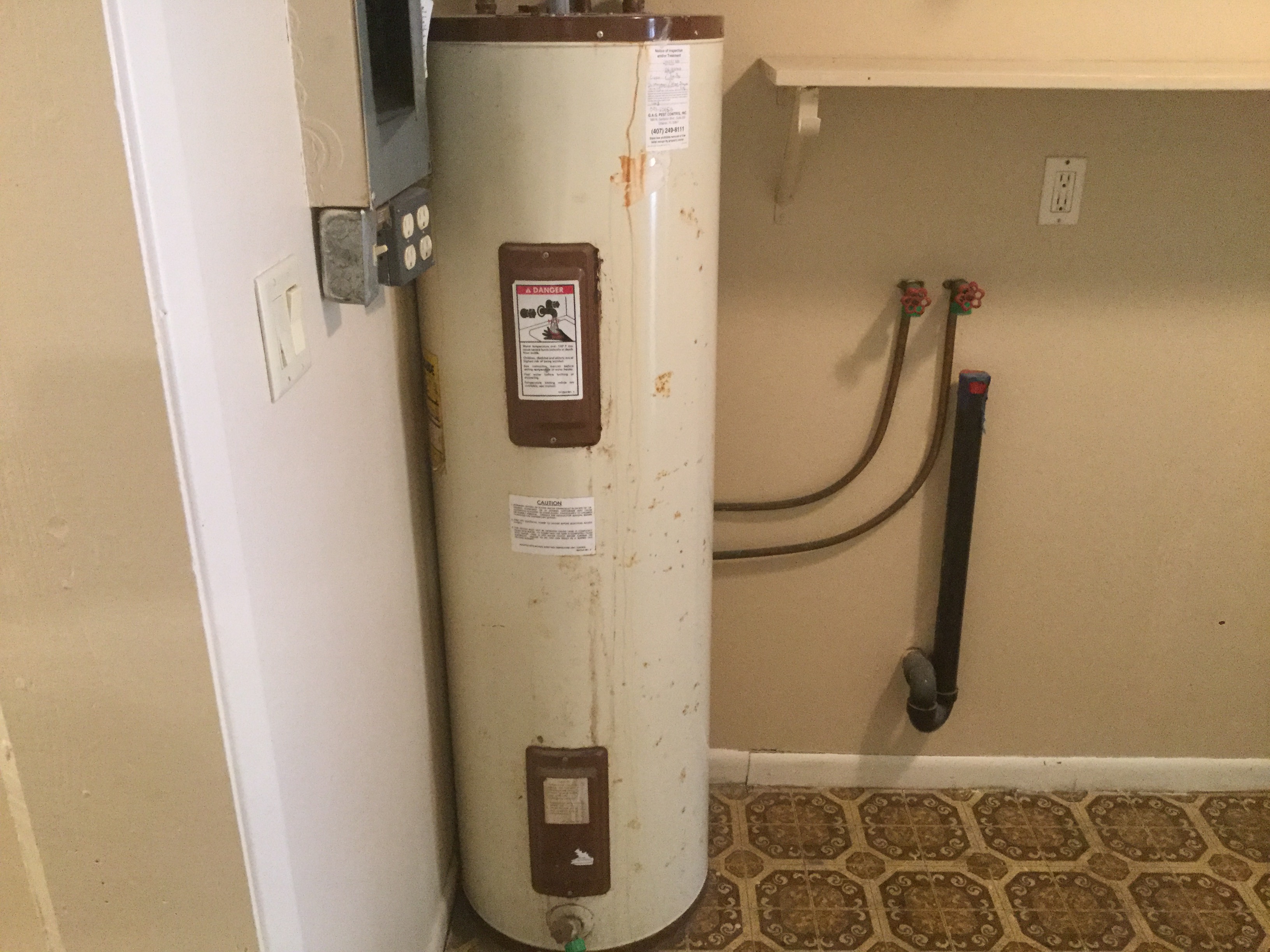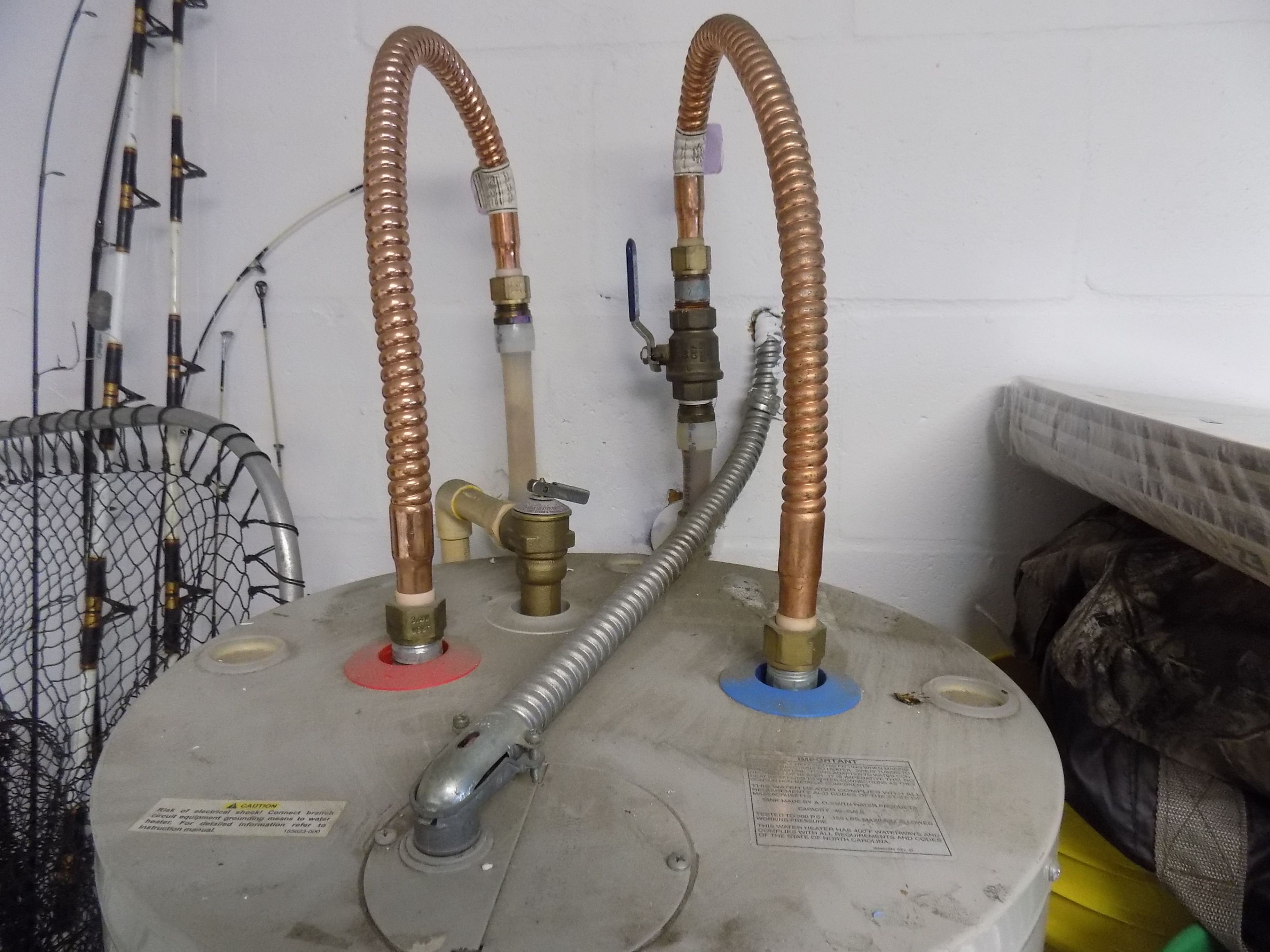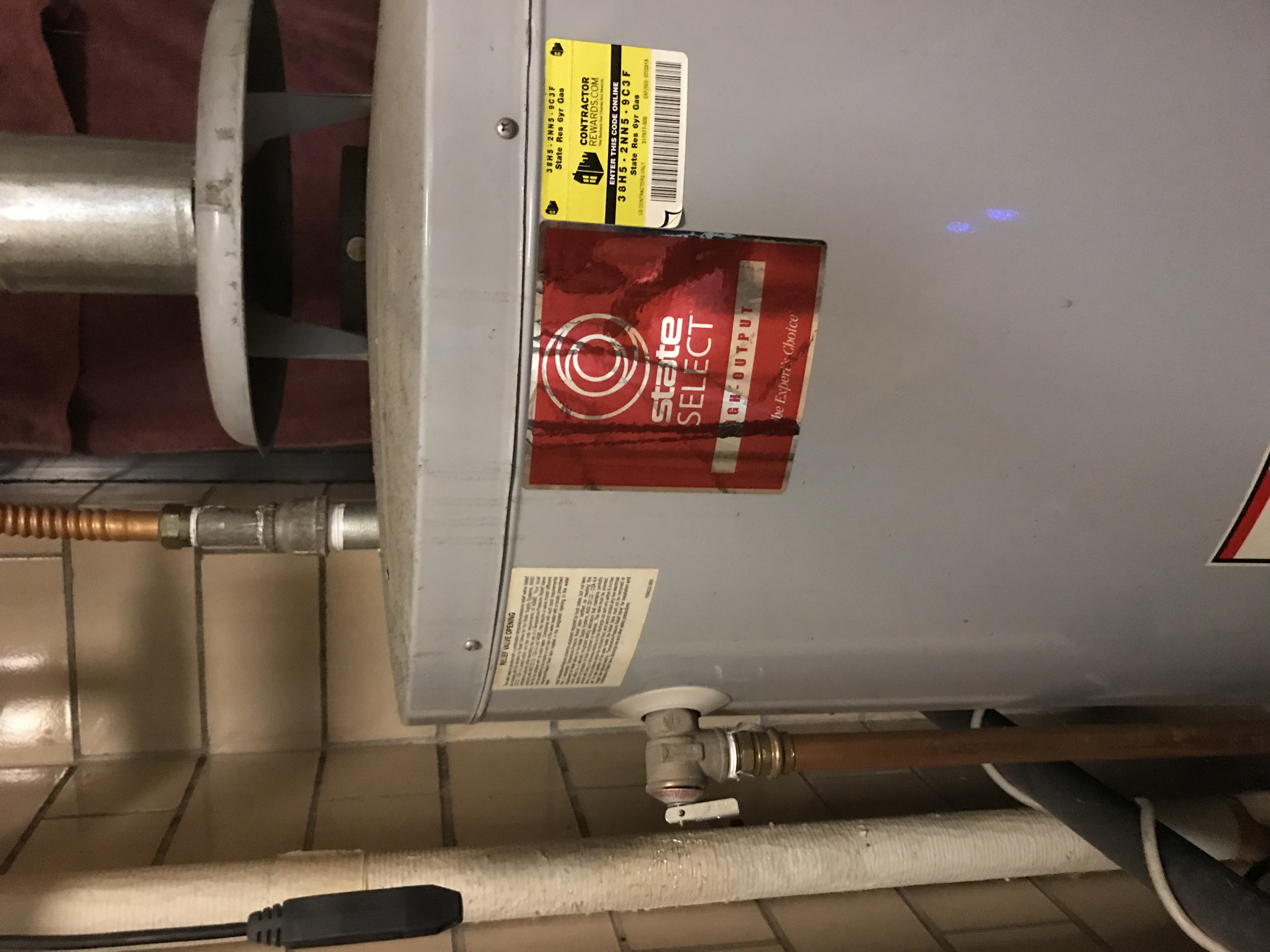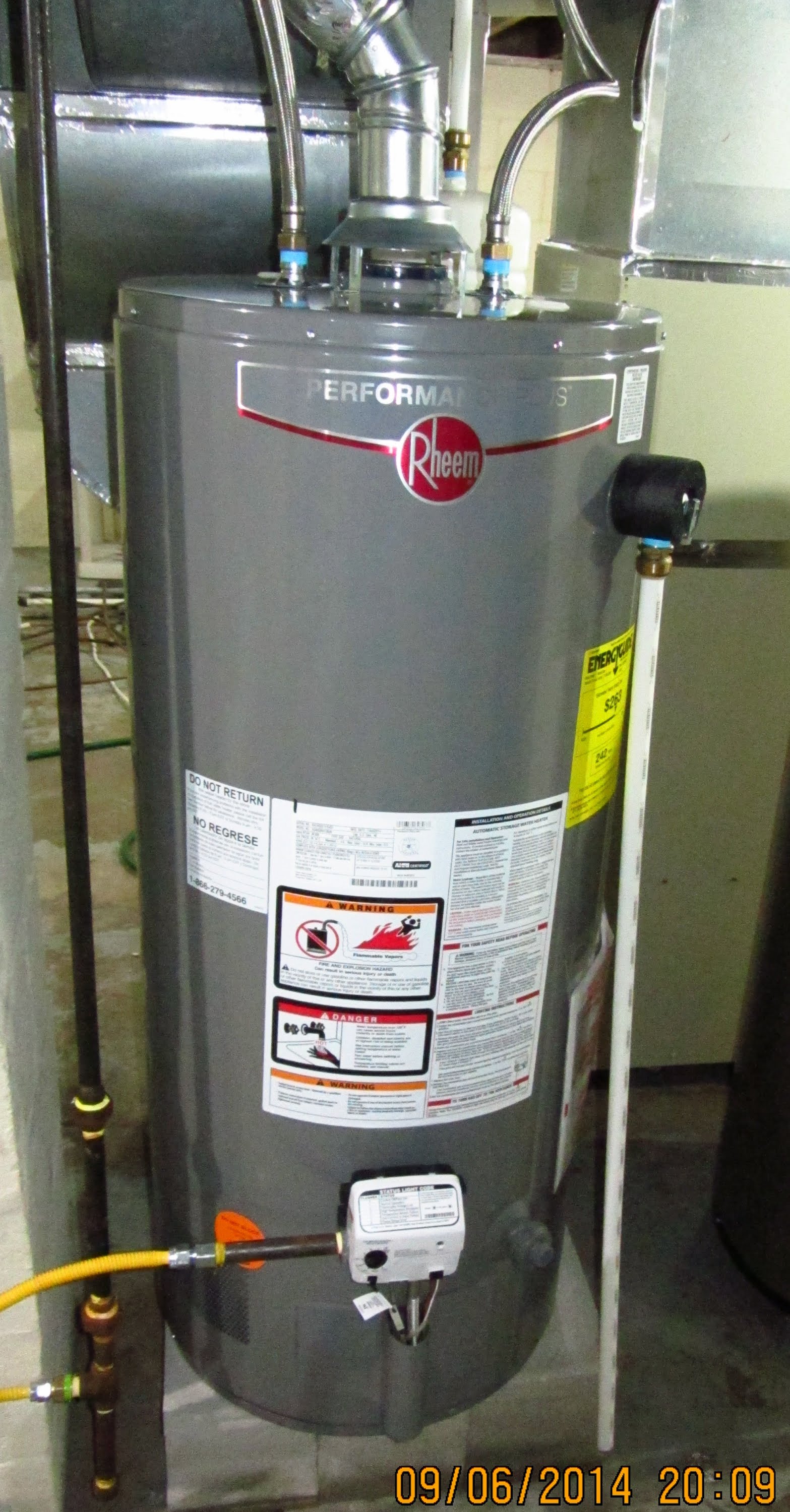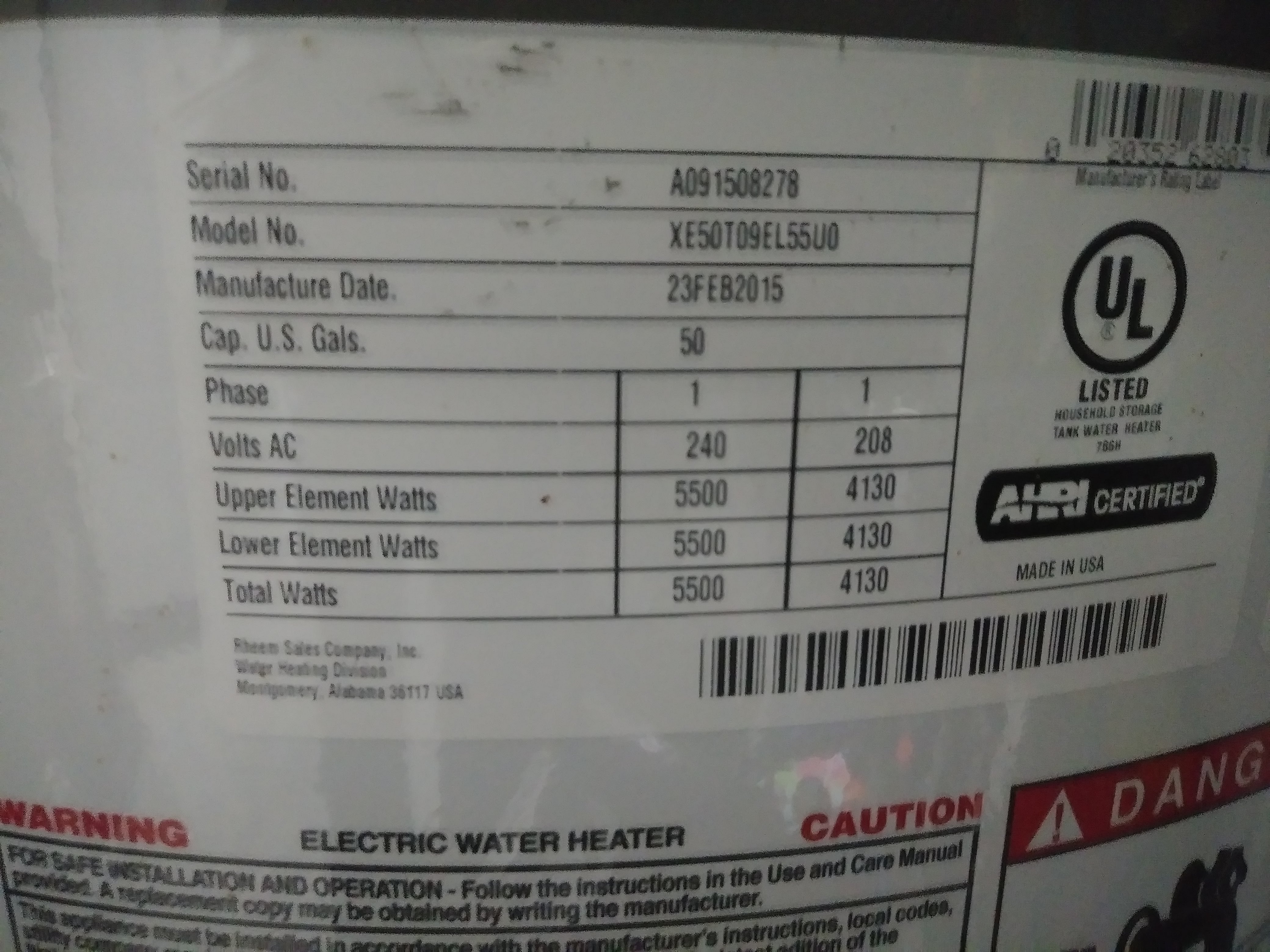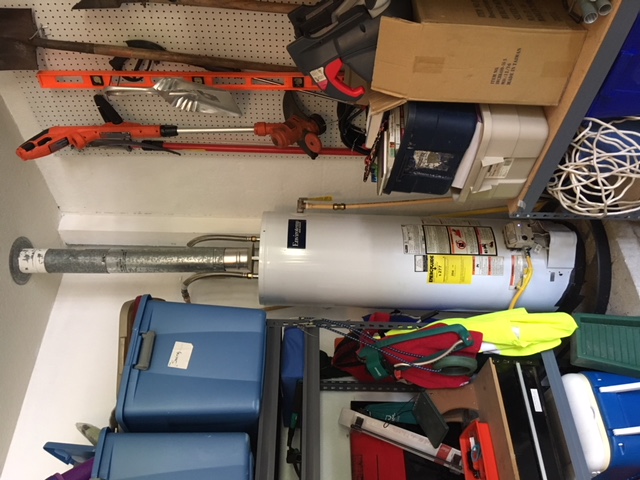The water heater did not have a safety drip leg attached to the temperature relief valve. This is an important safety feature. There was also no drip pan installed at the time of inspection. Rust was also visible on the tank.
The drip leg for the temperature and pressure relief valve on a hot water heater is an important safety feature. If hot water were to blow out of the valve it needs to be directed to the floor to avoid potentially spraying hot water onto someone.
This is a 40 Gallon Natural Gas Water Heater. This water heater is showing early signs of leaking and is also missing T&P Drain line. Water Heater is located in the garage laundry room and does not require a drip pan

Knowing the the meanings of the data plate numbers can be useful in determining the age of an appliance, such as a water heater. This information will assist the client in understanding how many time a water heater has been replaced or if it has been replaced at all.
The top of this water heater shows the inflow (cold water side) and the outflow (hot water side). It also clearly shows the TPR valve. The piping is a copper flexible type so therefore is more restrictive than hard piping. No signs of leaking or corrosion were detected, no defects were detected.
In reading the article on the TPR valve I noticed that there are 18 “should” enumerated with regards to the set up of the TPR valve system. I mention this because the water heater is but a very small portion of the entire scope of a complete home inspection. There is certainly food for thought in that observation with regards to the level of attention which must be paid while doing a home inspection.
This photo is of the top of a Reliance hot water tank. It has a 40 gallon capacity. Drip pan is installed and it is raised to a height of 18 as is code in this area. There appears to be some corrosion around the 90 degree fitting as it exits the tank on the hot water discharge side. Other than the corrosion there is no evidence of water standing or evidence of water streaking on the tank.
I read the article “TPR Valves”. These valves are a very important component to a hot water tank. We as inspectors must make sure they are present, not leaking, corroded, discharged correctly so as to not scald persons and have proper labeling. In the event that the TPR fails and pressure continues to build the effects will be catastrophic and possibly deadly.
A digital gas leak detection test can easily be performed to check both furnace and water heater for leaks. If you would like a free water pressure gauge you just have to ask. Its our token of appreciation for taking the time to read our site.
A digital gas leak detection test can easily be performed to check both furnace and water heater for leaks. If you would like a free water pressure gauge you just have to ask. Its our token of appreciation for taking the time to read our site.
The gas water heater in the garage had the vent flue disconnected. This is a dangerous condition that needs immediate repair by a qualified technician. Inadequate venting of exhaust fumes can cause overheating of space and invisible fumes of carbon monoxide.

Outhouses are a form of waste management that can be utilized. Insects, mold and amoeba can develop which actually help in the decomposition of waste. Proper venting allows gasses and odors to escape and keep it from overheating in the heat of the day. Thin layers of lime, sawdust and kitchen waste can be used to help layer and decompose the waste and assist in the control odors. Be aware to locate the outhouse at least 200 yards from a water supply and dig the pit to below the frost line.
Here is a photo of a gas fired water heater. The incoming gas line has a drip leg but there is no cut-off valve shown. This could be an issue if it is not on the incoming line. There is an expansion tank behind the unit and the TPR valve located on the right side piped to the floor. The incoming water lines and the flue look to be in good condition.
A hot water heater expansion tank is a small tank usually 1 to 3 gallons, connected to the cold water input to a water heating appliance. This tank is designed to accommodate fluctuations in the volume of the hot water supply system. Most residential tanks are designed to hold up to 150psi of pressure and can be mounted in any direction but they should be placed in a location where they can drain back to the tank.
This is the manufacturer’s label on a 40 gallon Rheem electric hot water heater. The heater is installed in a garage on a slab 7 inches off the floor. What strikes me as interesting, because I was in attendance when the heater was installed, was the lag between the manufacture date and install date - which was over one year. It teaches me that the manufacture date may not always correspond to the install date.
The attached is a picture of a water heat located in a residential garage. While it is surrounded by items stored in the garage it is accessible for service. Since located in the garage the water heater is elevated off the ground but only by 15.5" while the spec calls for a minimum of 18". All valves, venting, and 3rd party certifications are inline.
I chose the graphic “Sediment Trap at Gas-Fired Water Heater Tank” for this assignment. I grew up in the midwest, and gas was the best price choice for furnaces and water heaters. When I moved to Florida, I found that many of the hot water heaters I find are electric, or occasionally propane. The one thing I see most with propane is the lack of a setiment trap in the piping. I am curious as to the rule difference between NG and propane in this situation.
I read about the water heater expansion tanks. When inspecting these tanks the inspector should verify proper location; must be high enough above the water heater to ensure the water can effectively drain back into the water heater tank. You also need to check for proper bracing and leaks; both of which are often times either over looked or occur over time as a result of wear and tear.
Expansion tanks are used to help with the fluctuations in the volume of the water supply. Expanding water volume in a closed system can create dangerous amounts of pressure on the tank. The expansion tanks are much smaller than water heater tanks themselves, they typically will hold 2-3 gallons of water in residential homes. The tanks should be installed above or below the horizontal copper piping they may also be installed horizontally but additional support should be used as to not put too much stress on the copper piping. The expansion tank is not a substitute for a tpr valve.
This is a photo of a tpr, or temperature realease valve. The valve should always be located in the upper 6 inches of the tank. The reason for this is, the hottest water and most pressure is located near or at the top of the tank. Tpr valves are very important if the valve is too small it could be very problematic. the opening should be 3/4 inch nominal pipe size and should have a straight through area of 1/2 inch. The valve will open if the water pressure exceeds 150 psi, and if the water temperature exceeds 210 degrees.

